
Psilocybe mexicana is a psychedelic mushroom. Its first known usage was by the natives of North and Central America over 2,000 years ago. Known to the Aztecs as teotlnanácatl, from the Nahuatl teotl ("god") + nanácatl ("fungus"). This species was categorized by French botanist Roger Heim.
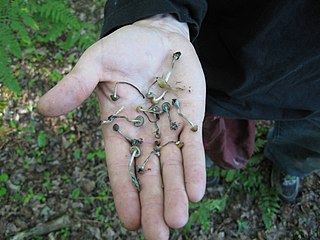
Psilocybe quebecensis is a moderately active hallucinogenic mushroom in the section Aztecorum, having psilocybin and psilocin as main active compounds. Native to Quebec, it is the most northern known psilocybin mushroom after Psilocybe semilanceata in northern Scandinavia. Macroscopically this mushroom somewhat resembles Psilocybe baeocystis.
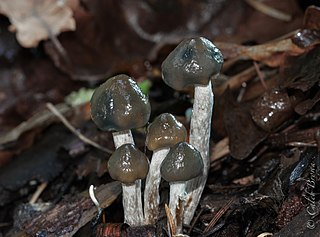
Psilocybe baeocystis is a psilocybin mushroom of the family Hymenogastraceae. It contains the hallucinogenic compounds psilocybin, psilocin and baeocystin. The species is commonly known by various names such as bottle caps, knobby tops, blue bells, olive caps.

Psilocybe ovoideocystidiata is a psilocybin mushroom, having psilocybin and/or psilocin as main active compounds. It is closely related to P. subaeruginascens from Java, P. septentrionalis from Japan, and P. wayanadensis from India. This mushroom was first documented by Richard V. Gaines in Montgomery County, Pennsylvania in June 2003. Although it is sometimes confused with Psilocybe caerulipes, it can be distinguished by its rhomboid spores, larger stature, earlier fruiting season and membranous annulus.

Psilocybe caerulipes, commonly known as blue-foot, is a rare psilocybin mushroom of the family Hymenogastraceae, having psilocybin and psilocin as main active compounds. An older synonym is Agaricus caerulipes.

Psilocybe zapotecorum is a psilocybin mushroom which has psilocybin and psilocin as main active compounds. It is in the section Zapotecorum.
Psilocybe subaeruginascens is a psychedelic mushroom which has psilocybin and psilocin as main active compounds. This mushroom is closely related to Psilocybe ovoideocystidiata.
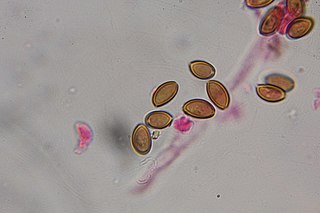
Psilocybe strictipes is a mushroom that grows on grassy meadows and lawns; It is found throughout the cool temperate and subarctic regions of the Northern Hemisphere and it is most common in Europe, and the Pacific Northwest region of North America. It contains the psychoactive compound psilocybin is closely related to Psilocybe semilanceata and Psilocybe pelliculosa. Psilocybe strictipes is commonly confused with Psilocybe semilanceata and can be differentiated by its lack of a papilla and a convex to subumbonate cap. "Strictipes" comes from the Latin words stricti (narrow) and pes (foot).
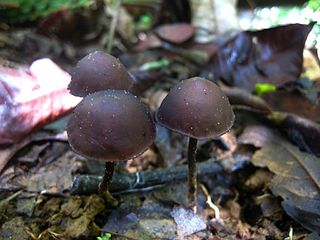
Psilocybe guilartensis is a psilocybin mushroom which has psilocybin and psilocin as main active compounds. It is common in Puerto Rico.
Psilocybe galindoi is a psychedelic mushroom in the section Mexicana, having psilocybin and psilocin as its main active compounds. It is also known as Psilocybe galindii. The species was named in honor of Mr. Carlos Galindo Arias and his family by Dr. Gastón Guzmán.
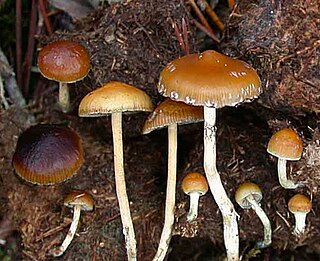
Psilocybe fimetaria is a psilocybin mushroom, having psilocybin and psilocin as main active compounds. It grows exclusively on horse and cow dung.
Psilocybe graveolens is an extremely rare psilocybin mushroom which has psilocybin and psilocin as main active compounds, discovered in the salt marshes or "meadows" of Hackensack, New Jersey. This mushroom is known for its strong and persistent odor.
Psilocybe liniformans var. americana, is a psilocybin mushroom in the family Hymenogastraceae. It is in the section Semilanceatae of Psilocybe and has psilocybin as its main active compound.

Psilocybe caerulescens, also known as landslide mushroom, is a psilocybin mushroom having psilocybin and psilocin as main active compounds. Along with Psilocybe mexicana and Psilocybe aztecorum, it is one of the mushrooms likely to have been used by the Aztecs and is currently used by Mazatec shamans for its entheogenic properties.

Psilocybe stuntzii, also known as Stuntz's blue legs and blue ringers it is a psilocybin mushroom of the family Hymenogastraceae, having psilocybin and psilocin as main active compounds.
Psilocybe cyanofibrillosa, also known as rhododendron psilocybe and blue-haired psilocybe, is a psilocybin mushroom of the family Hymenogastraceae having psilocybin and psilocin as main active compounds. First documented in 1980 in the Pacific Northwest, it is relatively uncommon and can be distinguished from other closely related species by its smaller spores and forking cheilocystidia. Psilocybe cyanescens also has forking cheilocystidia, but less often than Psilocybe cyanofibrillosa. Psilocybe cyanofibrillosa is also distinguished from Psilocybe cyanescens by an absence of pleurocystidia. The name of this species refers to the fibrils on the Stipe (mycology) that turn bluish in age, or when handled.
Psilocybe plutonia is a small psilocybin mushroom of the family Hymenogastraceae, believed to contain psilocybin and psilocin. It was first documented from Cuba. An older synonym is Agaricus plutonia.
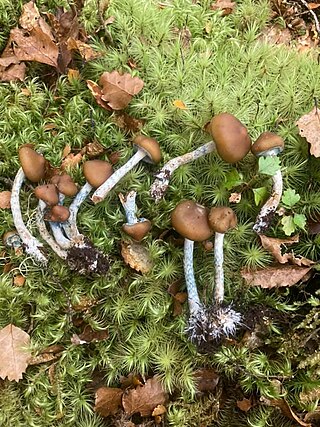
Psilocybe makarorae is a species of psilocybin mushroom in the family Hymenogastraceae. Officially described as new to science in 1995, it is known only from New Zealand, where it grows on rotting wood and twigs of southern beeches. The fruit body (mushroom) has a brownish cap with lighter coloured margins, measuring up to 3.5 cm (1.4 in) wide. The cap shape is either conical, bell-shaped, or flat depending on the age of the mushroom, and it features a prominent umbo. Although the whitish stem does not form a true ring, it retains remnants of the partial veil that covers and protects the gills of young fruit bodies. P. makarorae mushrooms can be distinguished from the similar North American species Psilocybe caerulipes by microscopic characteristics such as the presence of cystidia on the gill faces (pleurocystidia), and cheilocystidia with more elongated necks. Based on the bluing reaction to injury, P. makarorae is presumed to contain the psychedelic compounds psilocybin and psilocin.

Psilocybe neoxalapensis is a species of psilocybin mushroom in the family Hymenogastraceae. Found in Veracruz, Mexico, it was originally described in 2005 under the name Psilocybe novoxalapensis, but this naming was later determined to be invalid, and it was renamed P. neoxalapensis in 2009. It is in the Psilocybe fagicola complex with Psilocybe fagicola, Psilocybe oaxacana, Psilocybe banderillensis, Psilocybe columbiana, Psilocybe keralensis, Psilocybe herrerae, and Psilocybe teofiloi.

Psilocybe allenii is a species of agaric fungus in the family Hymenogastraceae. Described as new to science in 2012, it is named after John W. Allen, who provided the type collection. It is found in the northwestern North America from British Columbia, Canada to Los Angeles, California, most commonly within 10 miles (16 km) of the Pacific coast.















